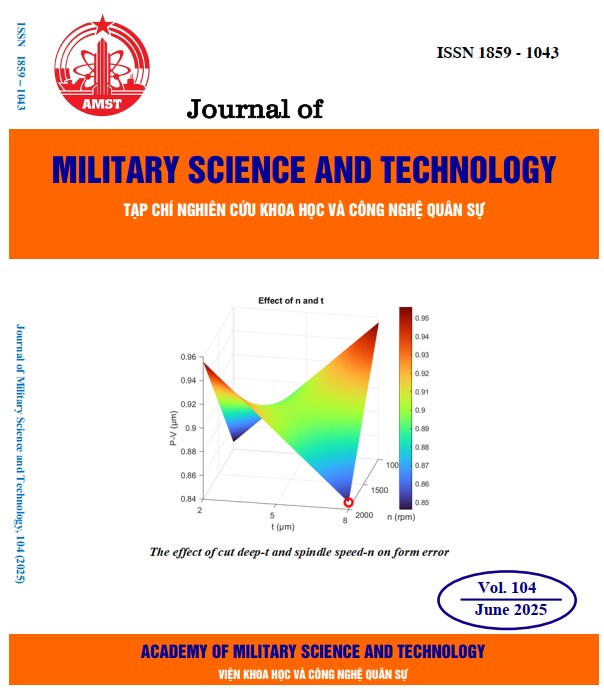Nghiên cứu ảnh hưởng của chế độ cắt và tối ưu hóa sai số biên dạng mặt cầu khi tiện siêu chính xác sử dụng Box-Berken và thuật toán Di truyền
289 lượt xemDOI:
https://doi.org/10.54939/1859-1043.j.mst.104.2025.192-200Từ khóa:
Tiện kim cương; Thấu kính; Bề mặt cầu; Sai số biên dạng; Thuật toán di truyền.Tóm tắt
Tiện kim cương siêu chính xác là phương pháp gia công quan trọng trong chế tạo quang học và linh kiện cơ khí chính xác, đặc biệt trong việc tạo hình bề mặt cầu. Tuy nhiên, sai số biên dạng của bề mặt gia công bị ảnh hưởng bởi nhiều yếu tố như tốc độ trục chính, chiều sâu cắt và lượng chạy dao. Nghiên cứu này phân tích ảnh hưởng của các thông số cắt đến sai số hình dạng khi gia công bề mặt cầu trên máy tiện siêu chính xác. Mười lăm thí nghiệm đã được thực hiện với các thông số gia công, bao gồm tốc độ trục chính, lượng chạy dao và chiều sâu cắt trong phạm vi khuyến nghị của máy. Mô hình sai số biên dạng được xây dựng dựa trên Box-Berken để mô phỏng và đánh giá độ chính xác của bề mặt gia công. Phân tích kết quả thí nghiệm cho thấy các thông số gia công đều có ảnh hưởng đến sai số biên dạng. Tốc độ trục chính và chiều sâu cắt cùng tăng hoặc giảm sẽ làm giảm sai số biên dạng, trong khi lượng chạy dao tăng thường làm tăng sai số biên dạng. Thuật toán di truyền được áp dụng để tối ưu hóa các thông số cắt, đạt sai số biên dạng tối thiểu 0,846 µm với tốc độ trục chính 2000 vòng/phút, tốc độ tiến dao 5 µm/phút và độ sâu cắt 8 µm. Nghiên cứu này phát triển mô hình dự đoán sai số hình dạng trong gia công tiện kim cương bề mặt cầu và tối ưu hóa thông số cắt. Đồng thời, nghiên cứu giúp nâng cao hiểu biết về ảnh hưởng của các thông số gia công đến sai số hình dạng, hỗ trợ dự đoán và tối ưu hóa quy trình nhằm nâng cao chất lượng gia công trong tiện kim cương.
Tài liệu tham khảo
[1]. Yuqi Dai et al., “Forced-based tool deviation induced form error identification in single-point dia-mond turning of optical spherical surfaces,” Precision Engineering, Vol. 72, pp. 83-94, (2021). DOI: https://doi.org/10.1016/j.precisioneng.2021.04.001
[2]. M. Tauhiduzzaman et al., “Form error in diamond turning,” Precision Engineering, Vol. 42, pp. 22-36, (2015). DOI: https://doi.org/10.1016/j.precisioneng.2015.03.006
[3]. Benny C. F. Cheung et al., “Editorial for the Special Issue on Advances in Ultra-Precision,” Mi-cromachines, Vol. 13, p. 2093, (2022). DOI: https://doi.org/10.3390/mi13122093
[4]. Julong YUAN et al., “Review on the progress of ultra-precision machining technologies,” Frontiers of Mechanical Engineering, Vol. 12, No. 2, pp. 158-180, (2017). DOI: https://doi.org/10.1007/s11465-017-0455-9
[5]. Vinod Mishraa et al., “Development of Aspheric Lenslet Array by Slow Tool Servo,” Materials To-day: Proceedings, Vol. 24, pp. 1602-1607, (2020). DOI: https://doi.org/10.1016/j.matpr.2020.04.481
[6]. Xiaonan Pu et al., “Fast tool servo-based ultra-precision diamond sculpturing for fabricating mi-cro-structured surfaces,” International Journal of Mechanical Sciences, Vol. 263, p. 108790, (2024). DOI: https://doi.org/10.1016/j.ijmecsci.2023.108790
[7]. Y. Huang et al., “Improving the performance of single point diamond turning surface with ion beam figuring,” Optik, Vol. 172, pp. 540-544, (2018). DOI: https://doi.org/10.1016/j.ijleo.2018.07.039
[8]. Chengsong Shu et al., “Fabrication of curved aspheric compound eye microlens array with high surface quality by precision glass molding,” Precision Engineering, Vol. 82, pp. 129-139, (2023). DOI: https://doi.org/10.1016/j.precisioneng.2023.03.009
[9]. Yung-Tien Liu et al., “An investigation into the aspheric ultraprecision machining using the re-sponse surface methodology,” Precision Engineering, Vol. 44, pp. 203-210, (2016). DOI: https://doi.org/10.1016/j.precisioneng.2015.12.006
[10]. C.L. He et al., “Characteristics of cutting force and surface finish in diamond turning of polycrys-talline copper achieved by friction stir processing (FSP),” Journal of Materials Processing Technol-ogy, Vol. 301, p. 117451, (2022). DOI: https://doi.org/10.1016/j.jmatprotec.2021.117451
[11]. Yi-Tung Kao et al., “A hybrid genetic algorithm and particle swarm optimization for multimodal functions,” Applied Soft Computing, Vol. 8, pp. 849-857, (2008). DOI: https://doi.org/10.1016/j.asoc.2007.07.002
[12]. Norfadzlan Yusup et al., “Evolutionary techniques in optimizing machining parameters: Review and recent applications (2007–2011),” Expert Systems with Applications, Vol. 39, pp. 9099-9027, (2012). DOI: https://doi.org/10.1016/j.eswa.2012.02.109
[13]. Qinghong Xue et al., “Genetic algorithm-based error correction algorithm for CNC turning machin-ing of mechanical parts,” Journal of Measurements in Engineering, Vol. 11, pp. 509-524, (2023). DOI: https://doi.org/10.21595/jme.2023.23501
[14]. V. Panwar et al., “Experimental investigations and optimization of surface roughness in turning of en 36 alloy steel using response surface methodology and genetic algorithm,” Materials Today: Pro-ceedings, Vol. 46, pp. 6474-6481, (2021). DOI: https://doi.org/10.1016/j.matpr.2021.03.642
[15]. Tingting Chen et al., “Research on the Surface Roughness Predictive Model of Austempered Ductile Iron Based on Genetic Algorithm,” Advanced Materials Research, Vol. 497, pp. 61-67, (2012). DOI: https://doi.org/10.4028/www.scientific.net/AMR.497.61
[16]. Harsita Kedia et al., “Optimization of process parameters in machining of Inconel 718 super alloy on HMT (NH22) capstan lathe using genetic algorithm subject to minimization of surface rough-ness,” Materials Today: Proceedings, Vol. 66, pp. 3910-3915, (2022). DOI: https://doi.org/10.1016/j.matpr.2022.06.390
[17]. Amith Gadagi et al., “A constrained multi-objective optimization of turning process parameters by genetic algorithm and particle swarm optimization techniques,” Materials Today: Proceedings, Vol. 42, pp. 1207-1212, (2021). DOI: https://doi.org/10.1016/j.matpr.2020.12.692
[18]. D. C. Montgomery, “Design and Analysis of Experiments”, John Wiley & Sons, (2006).







